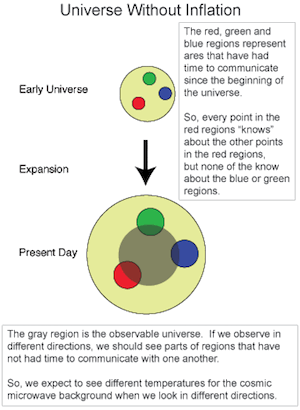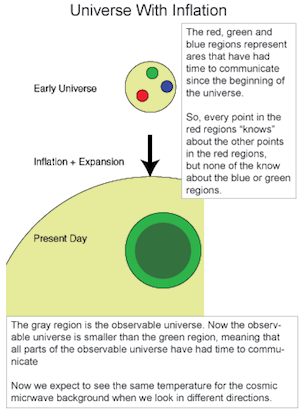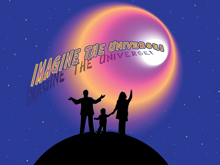Inflation in the Universe
The Big Bang theory has a problem, say scientists. It can't go from a tiny ball of energy to the universe we see today without some help. It needs an adjustment called inflation.
Astronomers observe that the temperature of the cosmic microwave background (CMB) is nearly smooth and uniform. The temperature can become uniform only if distant regions of the universe can interact and exchange energy. The fastest interactions occur at the speed of light. However, at the time the CMB radiation was given off, two regions that are far apart in space today would have been separated by a greater distance than the radiation could have ever traveled…even moving at the speed of light.
This situation would be similar to someone handing you a cup of very hot tea and handing your friend a cup of iced tea. If you and your friend were close enough, you could mix your cups of tea so that the tea in both cups would be nearly the same temperature. But imagine that immediately after you and your friend were handed your cups of tea, someone quickly pulled you and your friend so far apart that you would never be able to meet up again…even if you ran as fast as you could for your entire life. If this happened you would expect your cups of tea to always have a big difference in temperature. So why is the CMB temperature so nearly uniform?
Inflation Theory explains this by stating that shortly after the Big Bang, the universe expanded tremendously in a very short amount of time. This expansion grew the size of the universe from submicroscopic to the size of a golf ball in 10-35 seconds. Thus, regions once in contact with each other are now far apart in the universe. So if you and your friend were able to mix your cups of tea while you were still in contact with each other, then the temperature in your cups of tea would always be very similar no matter how far apart you moved.
After inflation, the expansion of the universe continued, but at a slower rate. As space expanded, the universe cooled and matter formed, and then protons and neutrons formed.
Inflation also predicts how stars and galaxies formed in the universe. Our universe would have been microscopic in size prior to inflation, and small differences in the density of matter would also be stretched by inflation. After inflation, these differences in the density of matter would be faint, but over time, the slightly over-dense regions would attract neighboring matter through the action of gravity. This would begin the gradual process of galaxy formation. So Inflation Theory explains why the CMB is so nearly uniform, and also how galaxies, stars, planets and people came to be!
Scientists are now more satisfied that with the addition of inflation, the Big Bang describes the universe we live in. •


Image credit: NASA's Cosmic Times
Evolution of the universe without inflation (left) and with inflation (right).



